What is Mochi? A beginner’s guide to Japanese rice cakes
Deeply rooted in Japanese culture, mochi is an ancient type of rice cake and Japanese food. Its deliciously sticky, stretchy texture will have you hooked from the first bite. But how is this delightful, whimsical food made?
Below, we explore Japanese mochi, from preparing these wagashi (traditional sweets) to different varieties, and even how to make this tasty Japanese rice cake treat at home with a step-by-step guide.
Is mochi a candy or dessert?
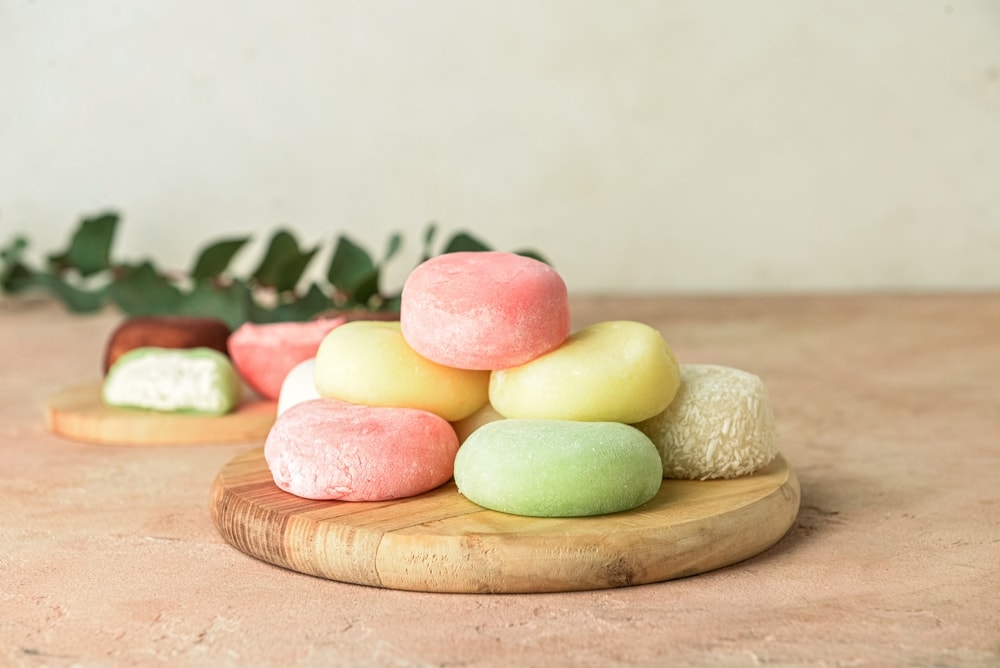
This Japanese dessert is made from sweet glutinous rice flour. This chewy, pillowy, sweet rice flour dough often includes food dyes that match the flavor/flavors of the filling. For example, if you find strawberry mochi in a local Asian market, you'll likely see it with a red hue. Japanese mochi is available in various flavors and colors, from green to pink and white. Often, this coloring is created with natural ingredients such as matcha powder or mugwort leaves. However, you'll also see versions where the pretty hues of this dessert are created from food coloring, especially in homemade recipes.
It's important to note that while it may seem like mochi is often on the sweeter side, there are an abundance of recipes that use mochi dough in a savory manner. Mochi rice cakes, pancakes, and dumplings are all offerings that can be sweet or savory. In savory versions, it's common to see an umami-rich soy sauce mixture drizzled on top. It's even common for this versatile ingredient to simply be pan-fried with oil for a crunchy, chewy treat!
What is a mochi in Japanese? What is mochi made of?
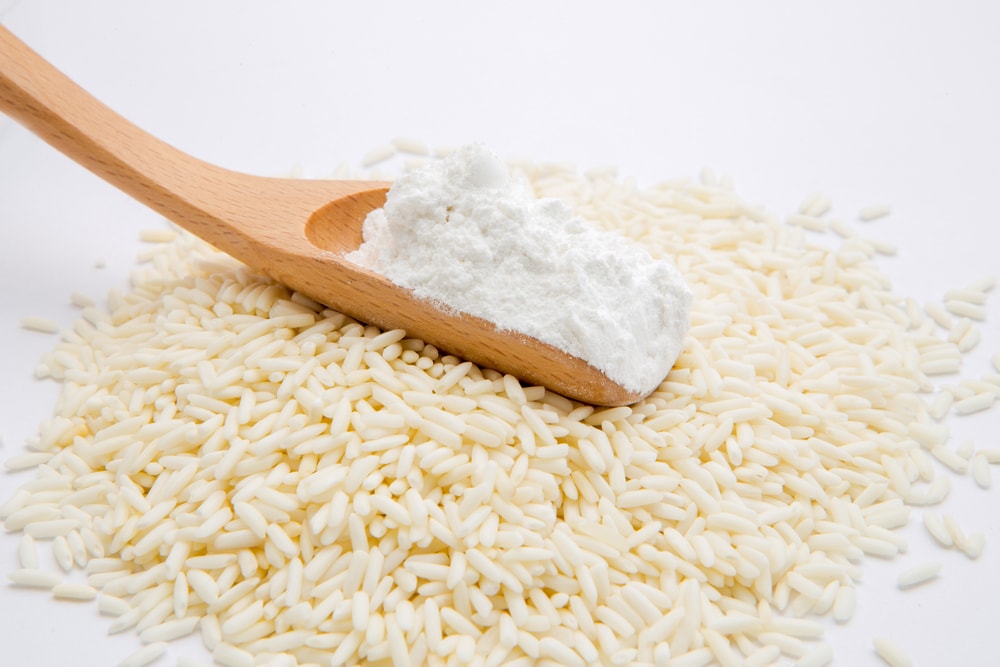
This traditional Japanese rice cake is made using mochigome, a short grain japonica glutinous rice. Depending on the intended result, it can also include additional ingredients like sugar, water, or cornstarch (for a coating on sweet mochi treats). Though Korea has its own version of mochi (Korean rice cakes, aka tteok), they are crafted from non-glutinous rice flour, creating a unique consistency that differs from the Japanese version.
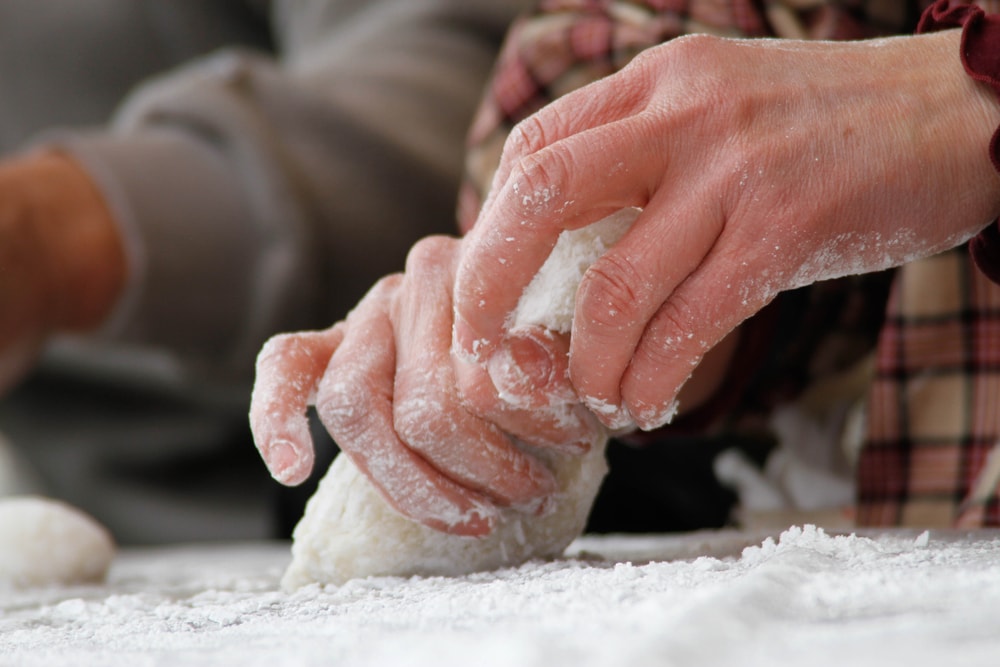
To create mochi dough traditionally, the rice is soaked overnight and then cooked via steaming. It's then pounded with a large wooden mallet until it becomes a paste. This paste is then shaped to create the finished product. It can be round, rectangular, or formed into long sticks perfect for pan-frying. In Japan, this ritual is traditionally performed as "mochitsuki."
In Japan, mochi has a deeper meaning than a tasty snack or meal. Its long history (originally beginning in the Jomon Period, 14,000-300 BCE) has ensured its inclusion in many important Japanese traditions. Many years ago, it was considered an ideal offering for the Gods. Once presented to the Gods, the mochi was sliced into sections and distributed among the attendees, as it was said to bring in good luck.
During the course of the Heian Period, this food became associated with New Year's and was consumed in celebration of the holiday. It has remained associated with New Year's, and is often available in abundant amounts near the holiday.
Why is mochi so popular in Japan?
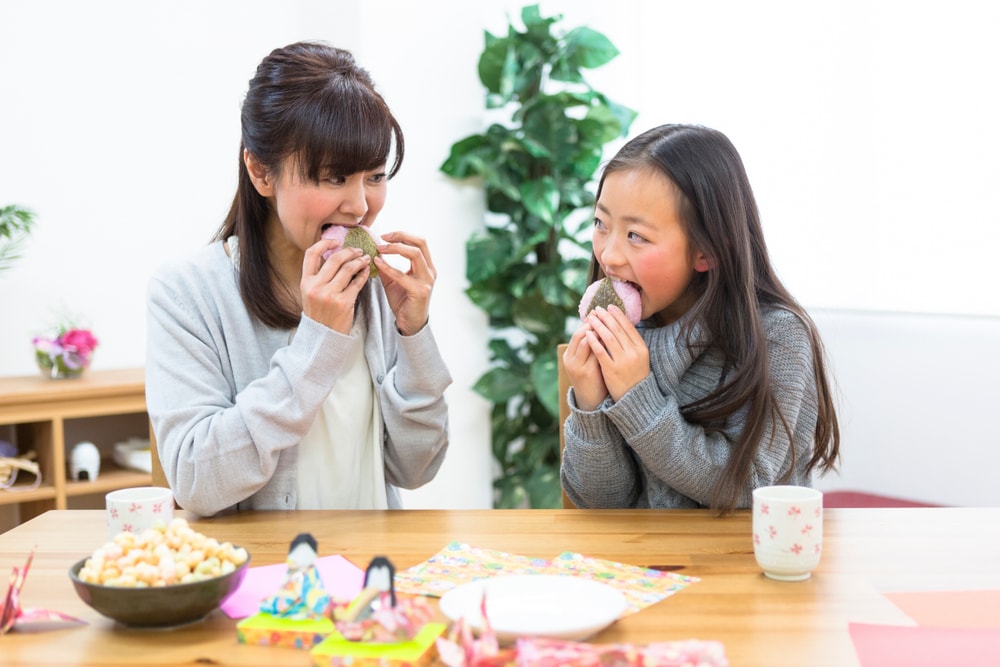
Ancient Japanese sages believed that mochi had a divine existence, so it became a holy food eaten to protect and gain prosperity. Now eaten year round, mochi has been associated with numerous festival and seasonal events, including Japanese New Year celebrations.
Besides its association with traditions and sacred festivities, Japanese mochi remains popular for many other reasons. For one, it's a highly versatile food that can be turned into a dessert and filled with an ice cream ball or sweet red bean paste or turned into a mochi donut. As mentioned, it can also be consumed as a savory food.
Once mochi dough is crafted, it is often dehydrated or preserved in a similar manner, making it a shelf-stable food. Because of this, it's a pantry staple for many people, especially due to its versatility.
What is mochi usually filled with?
What makes mochi special beyond its cultural significance is its subtle flavor, which pairs well with nearly any sweet fillings. Some popular options include anko (red bean paste), like in this Kinako Red Bean Mochi, chocolate, fresh fruit (like mango, strawberries, etc.), white bean paste, rice powder, butter, and various ice cream flavors. The fillings vary from creamy ganache to chunky fruit-filled treats. This is considered one of the most famous Japanese sweets, and for good reason!
Is Japanese mochi healthy?
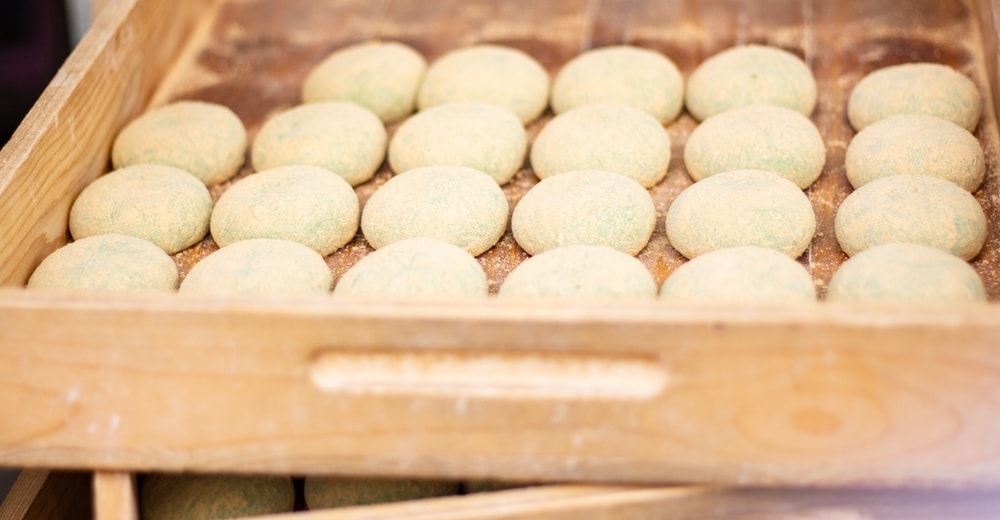
As fresh mochi is made of steamed glutinous rice, it is considered fairly healthy. Mochi is low in fat and cholesterol, making it a great treat for those aiming to keep their fat and cholesterol intake in check. It also contains vitamins C, E, K, Niacin, Pantothenic Acid, and Phosphorus. It provides excellent sources of calcium and iron folic acid.
Additionally, since mochi is crafted from glutinous rice flour, it is quite a satisfying and filling snack. Each serving contains a small amount of protein, which can also keep you full for longer. It's also relatively low in calories.
However, it does have a decent amount of sugar (about 6g per serving, depending on the filling/size of the mochi), so it may not be ideal for those who have diabetes or need to control their sugar intake. Is mochi health food approved? In Japan, it is considered a healthy food as it is said to promote stamina, aid with sugar imbalances, and even provide benefits to pregnant women.
Is mochi a traditional Japanese food?
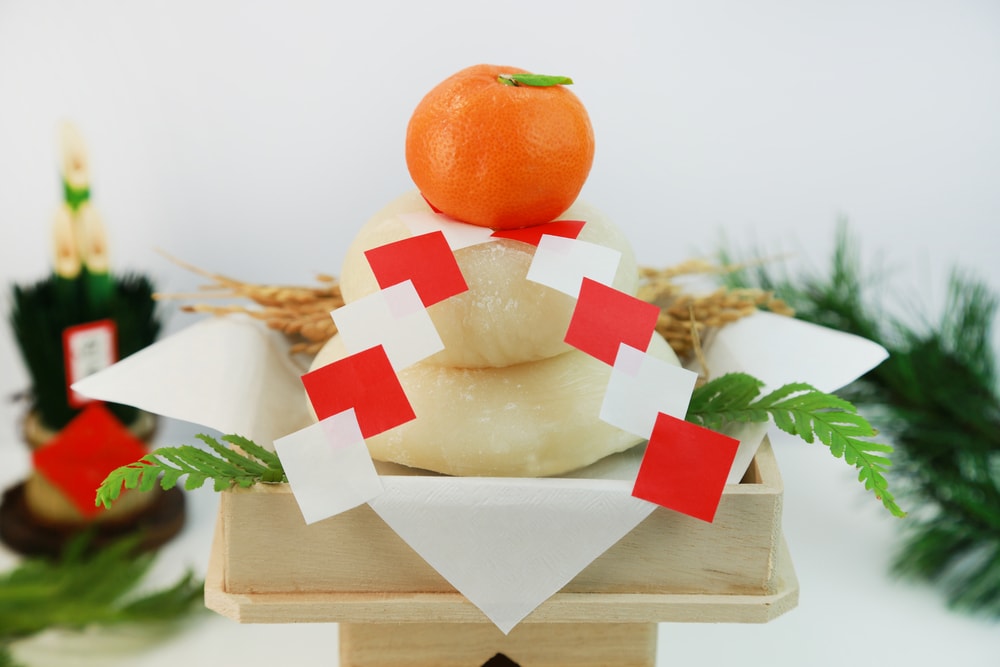
Yes, it is a traditional Japanese food. As mentioned, Japanese mochi has a long, rich history that extends many years into the past. This history, along with its cultural significance tied to various traditions and festivities, has ensured mochi remains a relevant treat through the years.
It's also often made via a traditional process, which involves processing and pressing mochigome, a rice variety known for its high starch content, sticky consistency, and mild sweetness. When processed in this manner, mochigome is steamed and beaten in a mortar until soft and chewy. Alternatively, it can be made from rice flours like mochiko or kudzu starch. Once it has become softened, the sweet rice dough will be formed into various shapes.
How is Mochi made?
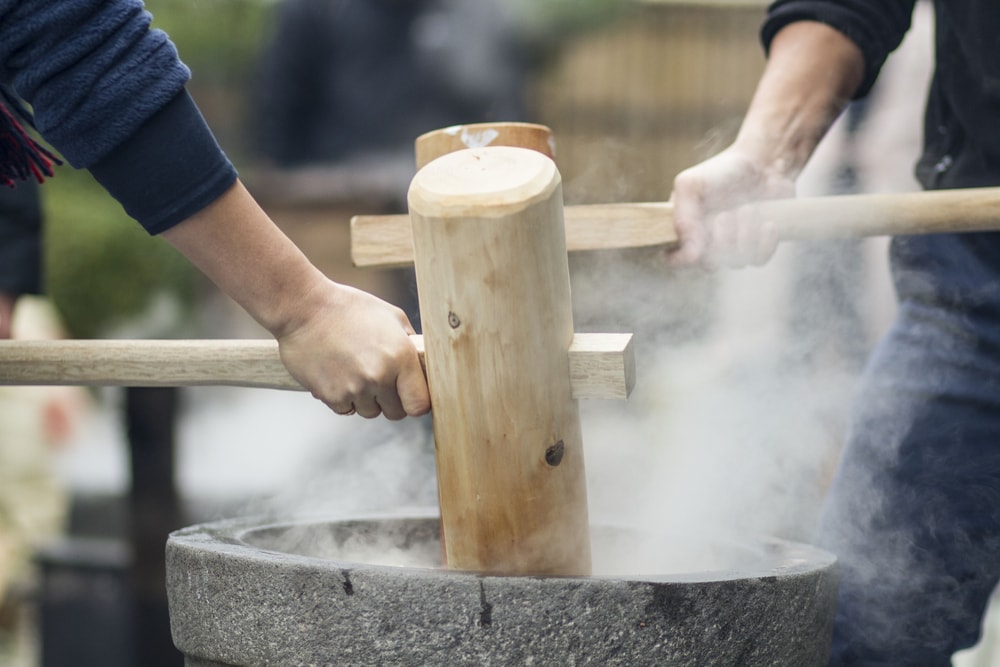
Depending on whether the mochi is made via the traditional method or at home with flour, the process will vary quite drastically. For the traditional method, Japanese mochi is produced using glutinous short grain rice (mochigome) - rice known for having a more chewable, sticky consistency than standard rice. Once the ingredients are gathered, the rice will soak in water anywhere from a few hours to overnight.

Then, it is steamed and pounded until it becomes a paste. This particular step, mochitsuki, requires a mortar (usu) and a heavy mallet (kine). It requires two people: one to use the mallet and pound the paste while the other shifts the mochi dough, adding water as needed. Both positions are essential, as they help create the desired texture and consistency of the dough. Mochitsuki is traditionally considered hard work, but most of it has been industrialized.
With mochiko flour, the process is much less laborious. Instead of pounding the dough with a mortar and mallet, you'll simply be mixing the flour with sugar, water, vinegar, and food coloring of choice. Then, microwaving the dough until "cooked" and filling with your desired pastes, ganache, fruit, or ice cream.
What is Mochi Ice Cream?
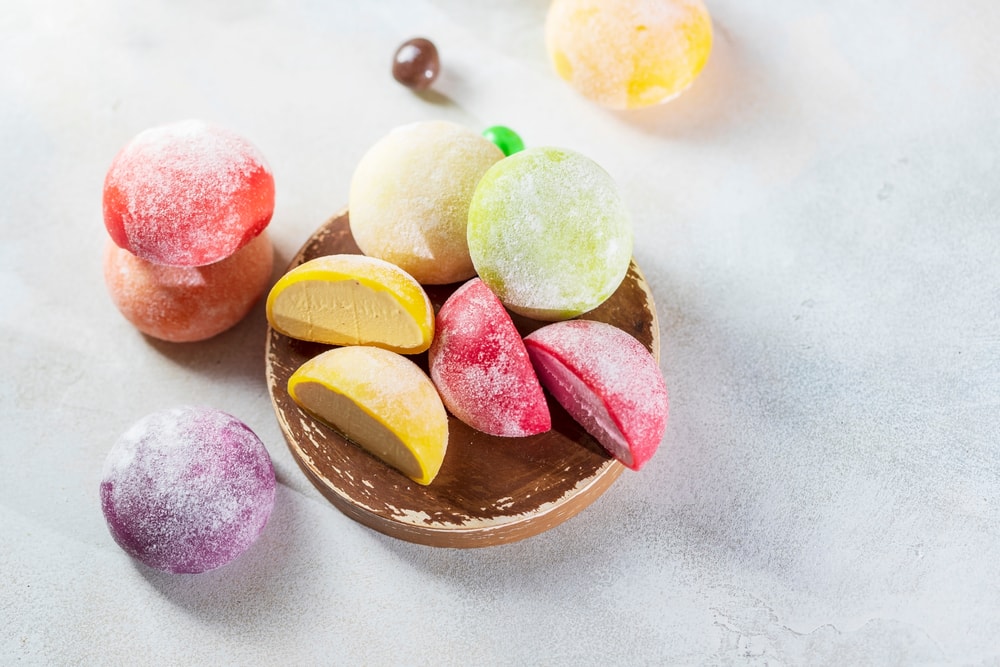
Mochi ice cream was recently introduced because of its chewy, sticky ice cream texture. Developed and created by a Japanese-American Frances Hashimoto, it features a sticky rice cake wrapper with an ice cream filling. The flavors for mochi ice cream range from traditional, like matcha and red bean paste, to boba, coffee, s'mores, and cake batter.
Types of Japanese Mochi
Japanese mochi is not a singular dessert. Instead, it's a versatile ingredient that is crafted into various wagashi. Beyond its more commonly known forms (like mochi ice cream), it's also added to drinks and savory Japanese foods. The list below offers insight into the types of available mochi, from sweet to savory. Once you craft homemade mochi (directions below), use these ideas to create fun mochi treats.
Yatsuhashi
Yashihara is a three-sided mochi from Kyoto and a popular meal souvenir. These delicious mochi typically include various fillings and flavors. There are three varieties available: one that simply consists of baked mochi dough strips with cinnamon and sugar, a steamed version of the dough strips, or an option with tasty fillings.
The third option (similar to a dumpling) was originally offered with red bean paste filling. However, the filling options have broadened through the years and now include choices like brown sugar, plum, sweet potato, and cherry blossom.
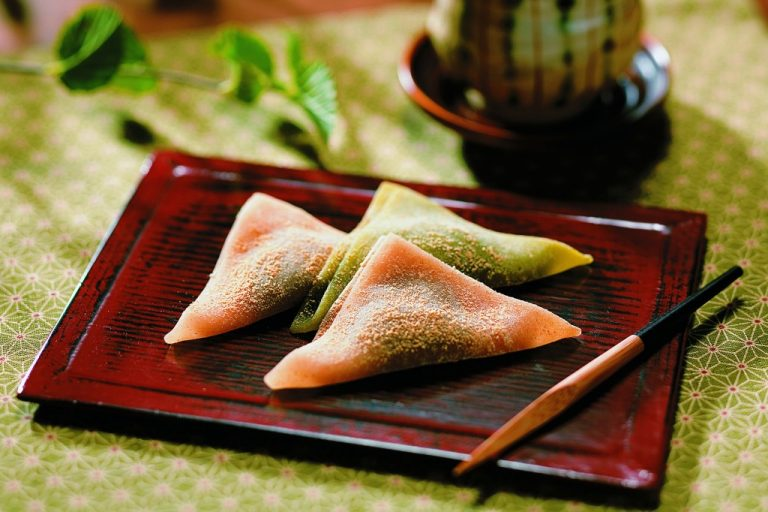
Dango
Dango technically is not traditional Mochi as it is produced using rice flour instead of glutinous rice. However, it's worth mentioning as it has a similar consistency to mochi, similar ingredients, and they are often confused for each other. Both are also types of Japanese rice cakes, which can make it all together more confusing.
This sweet treat is typically served on a skewer, with 3-5 rice balls per stick. Depending on the location where you purchase dango, you may see it in multiple colors (like this Triple Mochi Dango) or as a singular color coated in a sugar-soy sauce (mitarashi dango), which is often sold toasted.
Quite a few varieties of dango are available, especially as it's often associated with various festivals and celebrations. For example, springtime brings with it the celebration of Hanami (cherry blossom viewing), during which it is common to see white, pink, or green-colored dango.
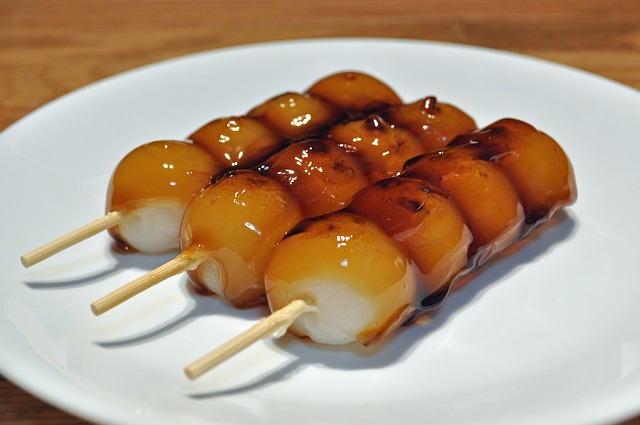
Daifuku
Daifuku mochi is an incredibly soft Japanese mochi with a sweet filling. These sweets can include various fillings, from anko (red bean paste) to ichigo (strawberry), chocolate ganache, fresh cream and fruit, coffee-flavored paste, green tea powder/paste, etc.

Bota Mochi (Ohagi)
Bota mochi/ohagi is quite similar to a daifuku mochi, except the filling is on the outside! These mochi feature chewy balls inside and a coating of red bean paste on the outside. This snack is considered a Buddhist holiday food served during different equinoxes or Higan holidays. They're typically consumed as an offering to the ancestors. These types are often referred to as "Botamamosi" in springtime but ohagi in autumntime.
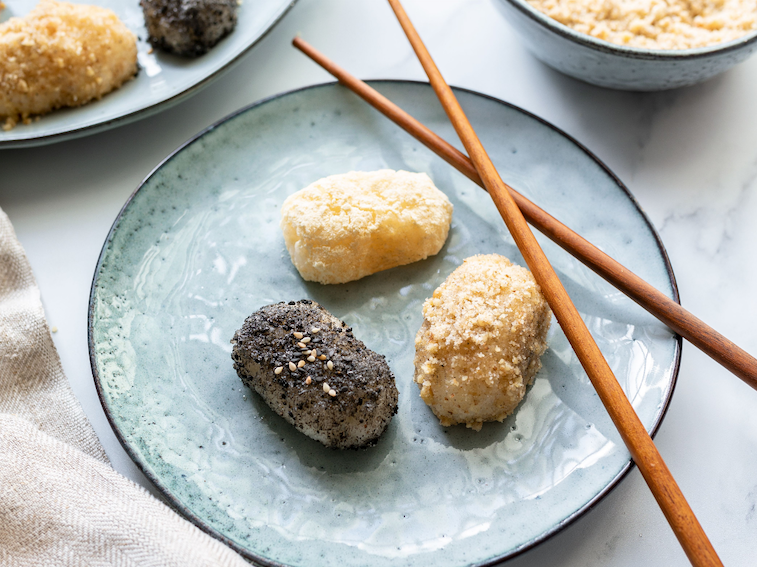
Kagami Mochi
Kagami mochi consists of one stack of 2 piece mochi with daidai, a sour Asian citrus fruit. It is typically used in ceremonies during New Years celebrations, and it has many meanings associated with it.
Kagami means "mirror," so this version of Japanese mochi is also known as mirror rice cake. Among its many meanings, Kagami mochi is said to represent yin and yang, the sun and moon, old and new, and happiness/good fortune.
It is a mochi shaped similarly to the shapes used in old Japanese temples. In December, kagami mochi is an iconic symbol of the Japanese New Year, when locals decorate shrines and offices for lifelong happiness. Once the mochi has been offered to the Gods, it is broken into pieces with a mallet and consumed as part of a Shinto ritual.

Mizu Shingen Mochi (Raindrop Cake)
Mizu shingen mochi (also called raincakes) is a Japanese traditional dessert completely unlike the rest of the mochi types listed. It is a clear, gelatinous wagashi made with water and agar agar powder or a rice flour. Because of its clear appearance, it has earned the nickname of raindrop cake.
This type of mochi does not have much of a flavor on its own, so it is served with toppings like kinako (roasted soybean powder) and brown sugar syrup.
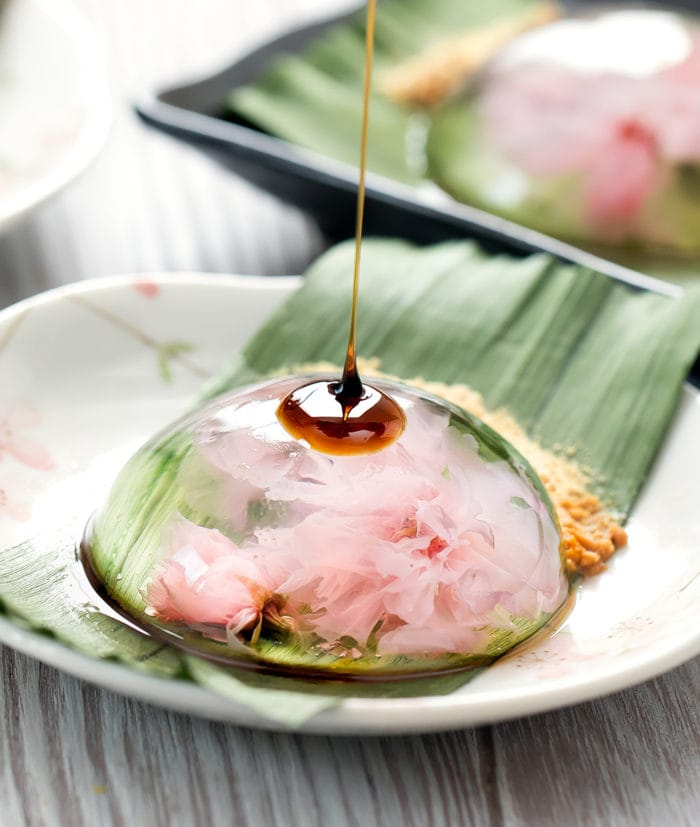
Hishi Mochi
This three-layer Japanese mochi typically is shaped like a rhombus/diamond. Often, it is crafted with three distinct layers, each with a different color (green, white, and pink or red). Hishi mochi is a delightful sweet treat which is commonly sold during the month of Hina Matsumi, aka the Girl's Day celebration. The festival is organized in Japan from 3 to 5 March to celebrate girls' success.
Each color represents a different meaning, though the specific rhombus shape is said to offer protection from evil spirits. Green symbolizes new growth/fertility. White can represent prosperity or purity. Red or pink are often included as the top layer, each with different meanings. When red is used, it can mean energy or simply represent various fruits/flowers, like cherry blossoms. Pink typically means good health and protection against bad luck.
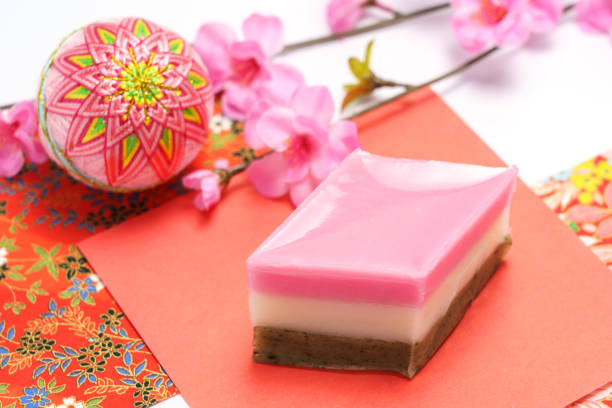
Yaki Mochi
This type of Mochi are usually eaten in the autumn or winter. They're a type of plain Japanese mochi, which are cooked in various manners including grilling, frying, or toasting. The mochi puffs up and is subsequently softer with heating. The end result of cooking this mochi is a crunchy, toasted outside and soft, and chewy inside.
This type of mochi is versatile, as it can be consumed with sweet or savory flavorings. For example, it goes well with a combination of dried seaweed sheets, soy sauce, and a small amount of sugar. Or, try it topped with kinako and brown sugar syrup or black honey (like seen in this Kuromitsu Kinako Mochi). It can also be a component of other dishes, such as soups or meat and vegetable skewers.

Kusa Mochi
Kusa mochi is naturally green because of the inclusion of mugwort, also known as yomogi. Mugwort is a type of grass typically used in Japanese herbal remedies. As this wild grass is kneaded into the mochi dough, it becomes a bright green color. Mugwort provides a flavor similar to tea in the mochi.
This mochi variety usually includes a sweet red bean paste in the center. Often, you'll see kusa mochi available for purchase in the springtime. Depending on where you purchase this mochi, you may also see a coating of kinako on top.
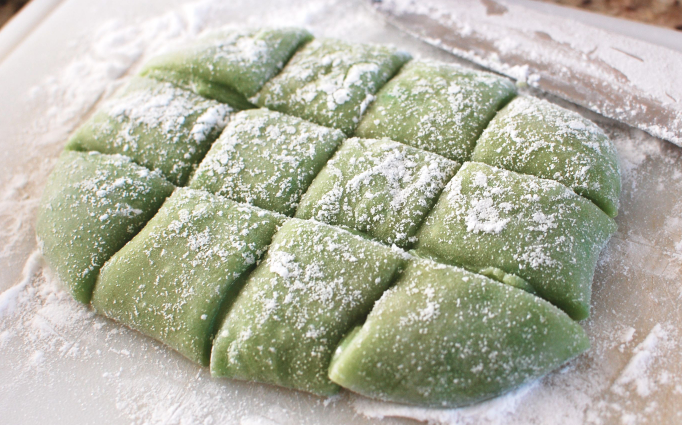
Isobe Maki (Isobe Yaki)
Isobuko maki / isobuko yaki is prepared from individual pieces of mochi grilled in Nori seaweed coated in soy sauce. In Japanese, "Isobe" translates to "rocky shore," a location where you'll often find a plethora of seaweed. Though it's common for this recipe to include mochi rice cakes, you'll also see versions where the seaweed is wrapped around taro root or scallops.
It is a simple but delicious snack bursting with umami taste. It's created by pan-frying rice cakes with oil, topping the mochi with soy sauce right from the pan, and wrapping them in seaweed. You can enjoy this delicious savory dish right from the pan—as it's best eaten hot!
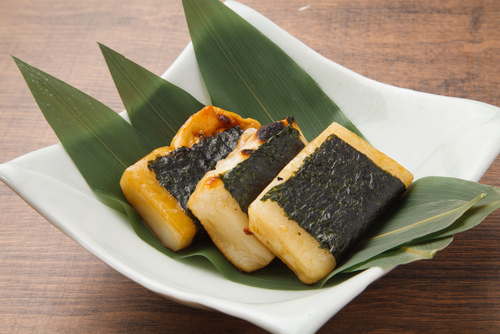
Ice Cream Mochi
Like daifuku, the mochi ball contains filling. However, instead of a paste, chocolate, or fruit, ice cream mochi contains a small ice cream scoop. This type of mochi also comes in quite a few flavors, and ranges in levels of sweetness depending on the brand and flavor. It's a refreshing treat typically consumed during warm weather months.
When purchasing ice cream mochi, look for them tucked away in the freezer section. When not in use, store them in the freezer as you would regular ice cream.
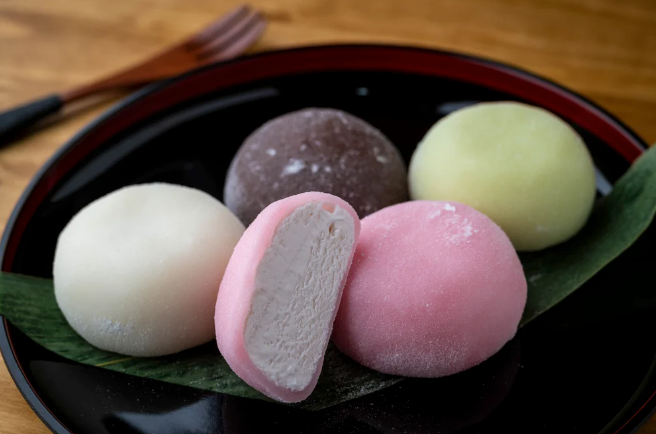
Kiri Mochi
Kiri mochi is a simple mochi piece cut up in rectangles. They are easily cooked and tossed together with other foods. This is one option that can be used to make yaki mochi, among other dishes. It's shelf-stable, so you can keep it in your pantry for many months. It's common to use kiri mochi in soups ranging from udon to ozoni and zenzai.
If you slice the kiri mochi into thin pieces, you can also turn it into rice crackers or rice chips. These chips/crackers can be fried and seasoned as you please.
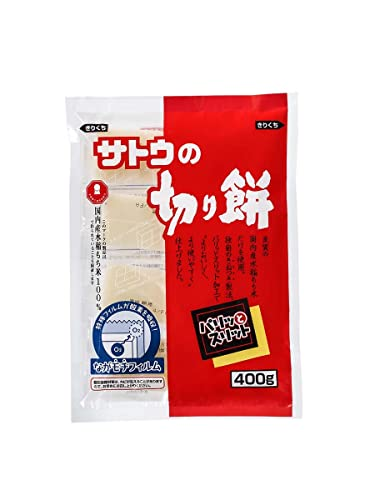
How to Make Japanese Mochi
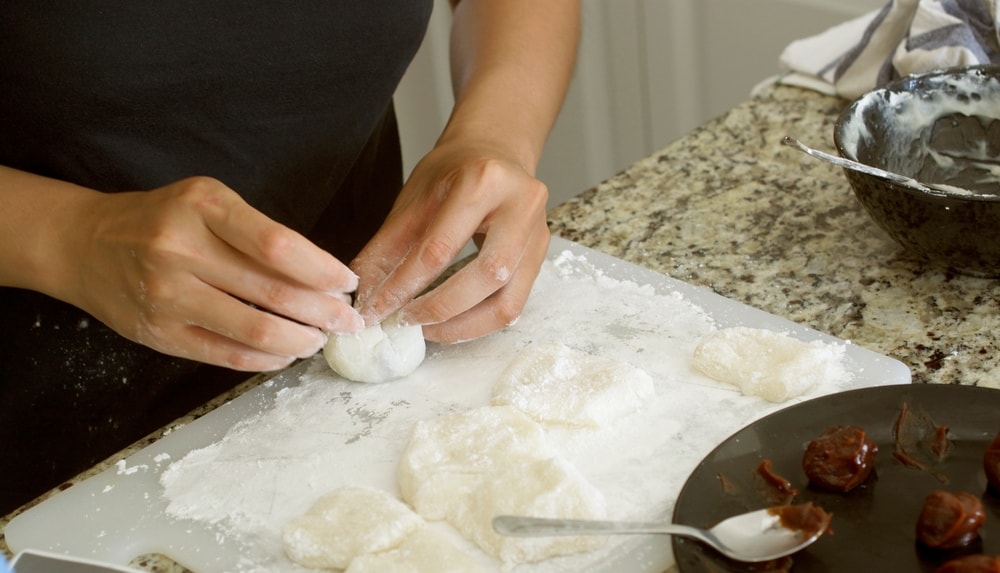
Crafting Japanese mochi at home is easier than ever with mochiko flour. The directions below will help you create delightful mochi snacks in no time.
Ingredients
-
Mochiko flour
-
Sugar
-
Water
-
White vinegar
-
Food coloring
-
Cornstarch
Directions
-
Whisk sugar and mochiko flour until well combined in a large microwave-safe bowl.
-
In a separate bowl, combine water and vinegar.
-
Mix the dry and wet ingredients together until a smooth dough forms.
-
Add food coloring of choice and mix.
-
Top the bowl with plastic wrap and microwave in one minute increments, stirring and replacing the plastic wrap each time you remove the dough from the microwave. This dough should take about four minutes to fully cook.
-
When the dough is cooked through, except the very center, it's ready to use. Remove it from the microwave and stir.
Making Mochi Ice Cream Balls

Once you have created your Japanese mochi dough, you can use it to make mochi ice cream or daifuku. The following steps will help you craft a delicious dessert.
-
Add cornstarch to a clean counter or cutting board, then roll out the dough until it is about 1/4" thick.
-
Cut into small 3" rounds. Then, add your fillings of choice (vanilla ice cream, fresh fruit, etc.). Be careful not to overstuff the rounds, or they won't close properly.
-
Pull the sides of the mochi dough up and around the filling, then pinch to close.
-
Place on a parchment paper-covered baking tray dusted with cornstarch. Then, set it in the freezer for one hour.
-
Once the mochi has set, put them in zip-loc bags and freeze them for up to three months.
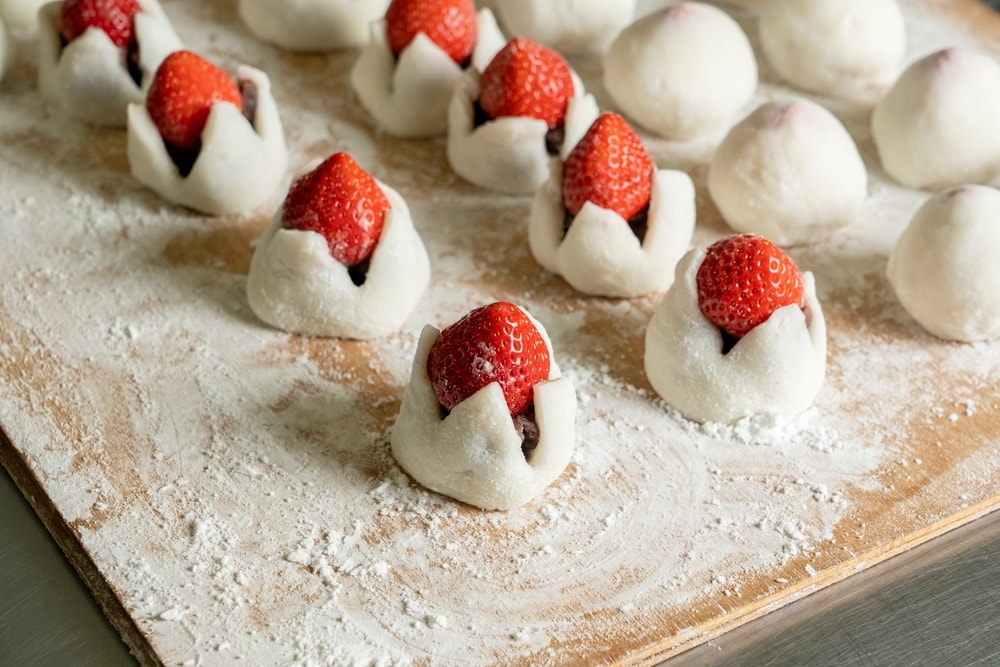
Tip: If you have extra dough, you can make daifuku instead. Simply use your favorite filling (red bean paste, fruit, chocolate) instead of ice cream. Then, store in an airtight container and consume within a few days.
Conclusion
With its versatility, adaptability to various flavors, and importance to Japanese culture, mochi remains an important food item in Japan and will continue to do so for many years. With its emergence in other countries, including the US, Japanese mochi has been a popular dessert, able to delight the tastebuds of many.
Whether you're new to mochi or already a fan, the above information will help you craft your own homemade version to share with loved ones. Enjoy it as a unique culinary delight, or use it to broaden your knowledge of Japanese culture.
If you don't have time to craft homemade mochi, you can also find delicious options in Sugoi Mart's Mochi Collection. With a range of flavors, colors, and varieties, Sugoi Mart has Japanese mochi for every taste bud. Can't find what you're looking for? Head to Bokksu Market for an additional array of Japanese mochi treats.
1 comment
Author Bio








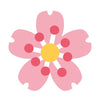








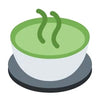














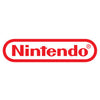
































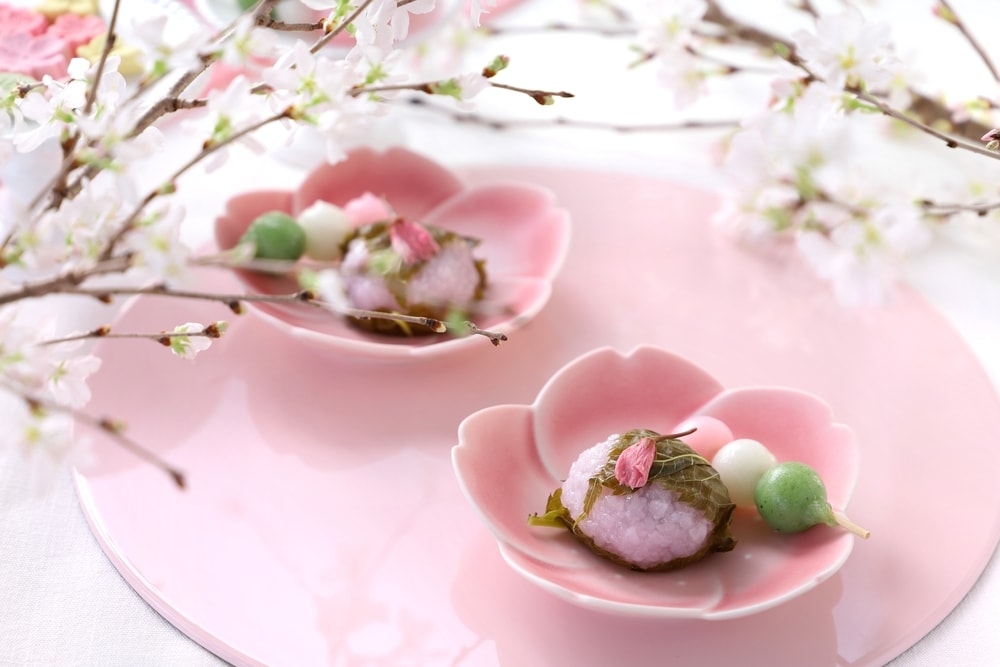









It would be very nice to have an original mochi recipe. Where is a lot of recipes in the web, but how to know wich one is an original one? Can you make a recomendation of a good Japanese recipe site?
Leave a comment